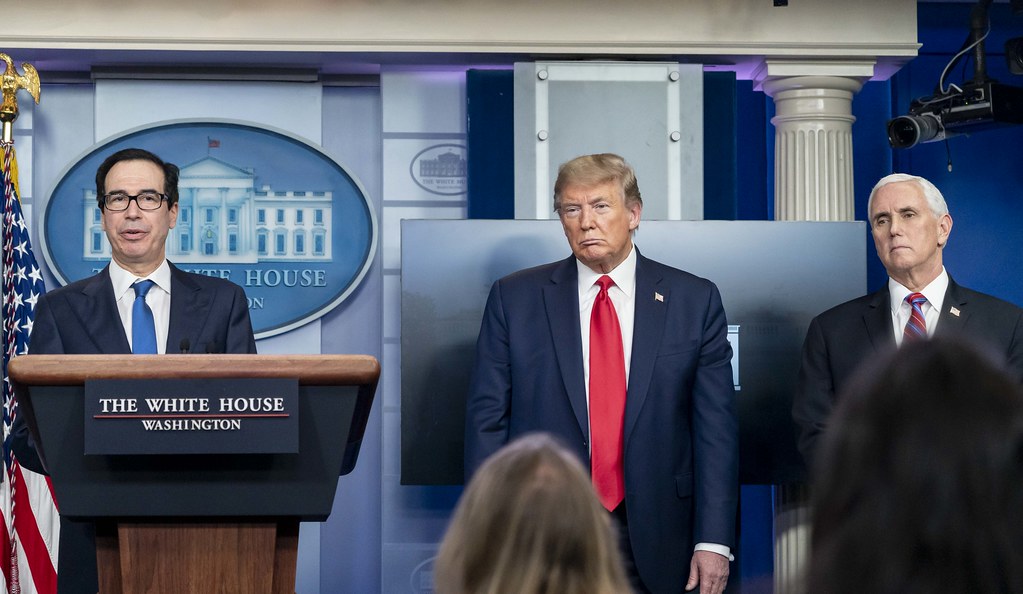The Normalization of Trade Security Exceptionalism
Trade authorities delegated to the president by Congress represent two distinct approaches to trade—a primary tariff-lowering approach and a secondary security-premised tariff-raising approach.

Published by The Lawfare Institute
in Cooperation With

In light of the coronavirus pandemic, the White House has restricted exports of certain medical products, and may go further still to increase domestic production, while also lifting tariffs on some imported medical equipment. Generally, however, the United States’s pandemic trade policy is not too dissimilar from its prepandemic direction. Moreover, not all recent developments in trade law are related to the pandemic. A May 1 executive order declaring under the International Emergency Economic Powers Act that “the unrestricted foreign supply of bulk-power system electric equipment constitutes an unusual and extraordinary threat to national security,” for example, was not a response specific to the coronavirus, but neither was it random.
The Trump administration regularly uses security-premised authorities to impose restrictions on trade and has done so since long before the pandemic came along. But the administration also uses statutory authorities to lower trade restrictions such as through its negotiation of a trade agreement with Japan or with the latest negotiations that began on May 5 toward a free trade agreement with the United Kingdom. While these dual moves may seem contradictory to some, in fact, these two sets of delegations of authority to the president are central tenets of the trade law system that Congress set up.
Since the first half of the 20th century, Congress has regularly delegated two distinct sets of trade authorities to the president. One set enables the president to eliminate tariffs through negotiations that lead to reciprocal free trade agreements with other countries. A second set enables the executive to impose tariffs when security so requires. Together, the two sets codify distinct approaches to trade—a primary tariff-lowering approach and a secondary security-premised tariff-raising approach. This phenomenon is what I refer to in a forthcoming article in the Stanford Law Review as “trade security exceptionalism.”
Importantly, this structural appraisal of U.S. trade law also illuminates a divergence in the way Congress oversees one set of delegations as compared to the other. With respect to the primary liberalizing delegations to make robust free trade agreements, Congress progressively added more procedural constraints. In contrast, Congress did little to nothing to control presidential action with respect to the security-premised exceptions. Both sets of delegations carve out a space for executive action, but one does so in a carefully circumscribed way while the other does not. This mismatch allows the president to act nearly without supervision when he wishes to set higher tariffs on certain goods or on goods coming from certain countries.
These exceptional delegations have flourished as of late to the point of becoming the new normal. I wrote about their initial use on Lawfare nearly two years ago, when import duties of 25 and 10 percent were first placed on certain steel and aluminum products, respectively, from all countries except those that negotiated exemptions or quotas. The president imposed those tariffs following an investigation by the Commerce Department pursuant to Section 232 of the Trade Expansion Act of 1962 in which Commerce found that imports of such products threatened to impair U.S. national security. Thereafter, the Commerce Department developed an exclusion process through which producers and importers filed more than 100,000 requests by the start of 2020 to have their products excluded from these special tariffs, and more such requests continue to come in. On occasion, the president has modified the tariffs, either by expanding their reach or increasing them on steel or aluminum products coming from particular countries.
Perhaps the most notable recent development, however, has been the growth in cases challenging the president’s tariff actions. More than 20 cases are working their way through the courts on Section 232 issues alone, while still others are pending on matters related to the special additional tariffs on products from China. In March 2019, a three-judge panel at the U.S. Court of International Trade (CIT) denied the American Institute for International Steel’s motion for summary judgment seeking a declaration that Section 232 was an unconstitutional delegation of authority to the president. Following an appeal, the institute filed a petition for certiorari at the Supreme Court, which is pending. In cases related to the president’s extended modifications of the steel and aluminum tariffs, the CIT has pushed back on the White House’s authority. In November, the CIT denied the government’s motion to dismiss one such complaint, finding that the president “lacked power to take new action and issued [a modifying proclamation] without the procedures as required by Congress.” Additionally, following the president’s modification to add tariffs on derivative products earlier this year, the CIT has also granted preliminary injunctions and temporary restraining orders requested by importers that prevent U.S. Customs and Border Protection from collecting duty deposits under that proclamation.
But these judicial actions have not stopped the government from proceeding with more Section 232 investigations. The Commerce Department has carried out three other such investigations in recent months and in the past week announced two more, raising the specter of additional tariffs premised on national security concerns. These investigations take up the national security implications of imports of autos and auto parts; uranium; titanium sponge; as of May 4, “laminations for stacked cores for incorporation into transformers” and related equipment; and, as of May 6, mobile cranes. The autos and auto parts investigation has garnered special attention by U.S. trading partners and by members of Congress in part as a result of its content and in part because of its lack of transparency. While it appears the Commerce Department concluded in at least broad terms that the import of autos and auto parts threaten to impair U.S. national security, Commerce has not complied with congressional requests and statutory requirements to release the investigation report, citing executive privilege due to ongoing negotiations.
Commentators and lawmakers have considered using Section 232 in still other ways—for example, possibly to add tariffs on imports for climate change issues, on oil imports or on medical supplies given the pandemic. But considering the procedural problems that have plagued the Section 232 investigations to date, members of Congress from both political parties have tended to put greater emphasis on reforming the statute to constrain the president’s authority rather than encourage him to use it more liberally.
Apart from these practical and legal considerations, there are broader normative issues with the structure of U.S. trade law and its competing authorities—some that exceptionally give the executive more power with less supervision when he invokes “security,” and others that require stringent checks and balances. Policymakers might consider whether and how to de-exceptionalize security from more open trade, especially since political theory and history have long seen increased trade and security as inextricably linked and as mutually reinforcing. But doing so is challenging when seeking to create a structure that can be applied consistently in ways that provide predictable and reliable tools for legal actors and market participants.
Instead of trying to reconcile politically charged ideas about trade and security, Congress might consider different types of disciplines on the executive branch for the exercise of those authorities, such as delegating more of them to independent agencies and reducing the president’s discretion or enhancing the limited subject matter jurisdiction of the Court of International Trade. Legislative reform could serve to tighten the loopholes that have led to the cascading tariffs: adding clear time limits to presidential action; enhancing transparency in reporting; and setting up administrative-law-governed programs for the tariffs themselves, or at least their exclusion processes.
In the past two years, U.S. trade law exceptions have been normalized not just in government action but largely in public consciousness. As the pandemic in some ways renews discussions of these questions and in other ways shifts attention to different trade policy matters, aspirations for all three branches of government should be for a trade law system that facilitates appropriate recovery rather than plays authorities off one another.





